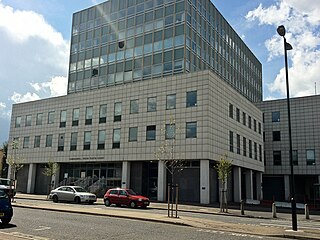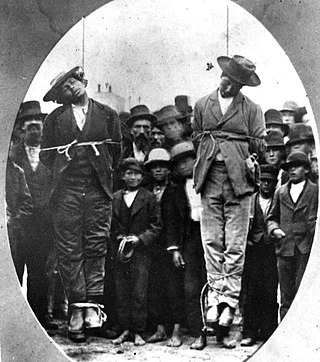Transformative justice is a series of practices and philosophies designed to create change in social systems. Mostly, they are alternatives to criminal justice in cases of interpersonal violence, or are used for dealing with socioeconomic issues in societies transitioning away from conflict or repression. Other fields of practice have adopted transformative justice, including to address groups' work on other social issues and climate justice.

The prison-industrial complex (PIC) is a term, coined after the "military-industrial complex" of the 1950s, used by scholars and activists to describe the many relationships between institutions of imprisonment and the various businesses that benefit from them.

Juvenile delinquency, also known as juvenile offending, is the act of participating in unlawful behavior as a minor or individual younger than the statutory age of majority. These acts would otherwise be considered crimes if the individuals committing them were older. The term delinquent usually refers to juvenile delinquency, and is also generalised to refer to a young person who behaves an unacceptable way.

School discipline relates to actions taken by teachers or school organizations toward students when their behavior disrupts the ongoing educational activity or breaks a rule created by the school. Discipline can guide the children's behavior or set limits to help them learn to take better care of themselves, other people and the world around them.

Incarceration in the United States is one of the primary means of punishment for crime in the United States. In 2023, over five million people were under supervision by the criminal justice system, with nearly two million people incarcerated in state or federal prisons and local jails. The United States has the largest known prison population in the world, it has 5% of the world’s population, and 20% of the world’s incarcerated persons. China, with four times more inhabitants, has fewer persons in prison. Prison populations grew dramatically beginning in the 1970s, but began a decline around 2009, dropping 25% by year-end 2021.

Critical Resistance is a U.S. based organization with the stated goal of dismantling what it calls the prison-industrial complex (PIC). Critical Resistance's national office is in Oakland, California, with three additional chapters in New York City, Los Angeles, and Portland, Oregon.

Juvenile court, also known as young offender's court or children's court, is a tribunal having special authority to pass judgements for crimes committed by children who have not attained the age of majority. In most modern legal systems, children who commit a crime are treated differently from legal adults who have committed the same offense.

The American juvenile justice system is the primary system used to handle minors who are convicted of criminal offenses. The system is composed of a federal and many separate state, territorial, and local jurisdictions, with states and the federal government sharing sovereign police power under the common authority of the United States Constitution. The juvenile justice system intervenes in delinquent behavior through police, court, and correctional involvement, with the goal of rehabilitation. Youth and their guardians can face a variety of consequences including probation, community service, youth court, youth incarceration and alternative schooling. The juvenile justice system, similar to the adult system, operates from a belief that intervening early in delinquent behavior will deter adolescents from engaging in criminal behavior as adults.
Juvenile delinquency in the United States refers to crimes committed by children or young people, particularly those under the age of eighteen.

Race in the United States criminal justice system refers to the unique experiences and disparities in the United States in regard to the policing and prosecuting of various races. There have been different outcomes for different racial groups in convicting and sentencing felons in the United States criminal justice system. Although prior arrests and criminal history is also a factor. Experts and analysts have debated the relative importance of different factors that have led to these disparities.

The United States incarcerates more of its youth than any other country in the world, although reports claim China has around 600,000 juveniles imprisoned which would be more than the US, through the juvenile courts and the adult criminal justice system, which reflects the larger trends in incarceration practices in the United States. In 2010, approximately 70,800 juveniles were incarcerated in youth detention facilities alone. As of 2006, approximately 500,000 youth were brought to detention centers in a given year. This data does not reflect juveniles tried as adults. As of 2013, around 40% were incarcerated in privatized, for-profit facilities.
In the United States, the school-to-prison pipeline (SPP), also known as the school-to-prison link, school–prison nexus, or schoolhouse-to-jailhouse track, is the disproportionate tendency of minors and young adults from disadvantaged backgrounds to become incarcerated because of increasingly harsh school and municipal policies. Additionally, this is due to educational inequality in the United States. Many experts have credited factors such as school disturbance laws, zero-tolerance policies and practices, and an increase in police in schools in creating the "pipeline". This has become a hot topic of debate in discussions surrounding educational disciplinary policies as media coverage of youth violence and mass incarceration has grown during the early 21st century.

The alternatives to imprisonment are types of punishment or treatment other than time in prison that can be given to a person who is convicted of committing a crime. Some of these are also known as alternative sanctions. Alternatives can take the form of fines, restorative justice, transformative justice or no punishment at all. Capital punishment, corporal punishment and electronic monitoring are also alternatives to imprisonment, but are not promoted by modern prison reform movements for decarceration due to them being carceral in nature.

Incarceration prevention refers to a variety of methods aimed at reducing prison populations and costs while fostering enhanced social structures. Due to the nature of incarceration in the United States today caused by issues leading to increased incarceration rates, there are methods aimed at preventing the incarceration of at-risk populations.

Criminal justice reform seeks to address structural issues in criminal justice systems such as racial profiling, police brutality, overcriminalization, mass incarceration, and recidivism. Reforms can take place at any point where the criminal justice system intervenes in citizens’ lives, including lawmaking, policing, sentencing and incarceration. Criminal justice reform can also address the collateral consequences of conviction, including disenfranchisement or lack of access to housing or employment, that may restrict the rights of individuals with criminal records.
Victor M. Rios is a professor, author, and speaker. His research examines how inequality plays a determining role in the educational and life outcomes of marginalized populations. Rios is of Mexican American origin. He has written several books and is known for developing the theories of the youth control complex, Cultural Misframing, Legitimacy Policing, Masbloom, and Educator Projected Self-Actualization.

James Forman Jr. is an American legal scholar currently on leave from serving as the J. Skelly Wright Professor of Law at Yale Law School. He is the author of Locking Up Our Own: Crime and Punishment in Black America, which won the 2018 Pulitzer Prize for General Nonfiction, and a co-founder of the Maya Angelou School in Washington, D.C.
The prison–industrial complex is the rapid expansion of US inmates and prisons in favor of private prison companies and businesses that profit from the services needed in the construction and maintaining of prisons. The businesses benefit and profit from cheap prison labor, food services, medical services, surveillance technology, and construction. The financial incentive of building prisons encourages incarceration and affects people of color at disproportionately high rates. Native Americans are the largest group per capita in the US prison system and are more likely to be affected by police violence than any other racial group.

Decarceration in the United States involves government policies and community campaigns aimed at reducing the number of people held in custody or custodial supervision. Decarceration, the opposite of incarceration, also entails reducing the rate of imprisonment at the federal, state and municipal level. As of 2019, the US was home to 5% of the global population but 25% of its prisoners. Until the COVID-19 pandemic, the U.S. possessed the world's highest incarceration rate: 655 inmates for every 100,000 people, enough inmates to equal the populations of Philadelphia or Houston. The COVID-19 pandemic has reinvigorated the discussion surrounding decarceration as the spread of the virus poses a threat to the health of those incarcerated in prisons and detention centers where the ability to properly socially distance is limited. As a result of the push for decarceration in the wake of the pandemic, as of 2022, the incarceration rate in the United States declined to 505 per 100,000, resulting in the United States no longer having the highest incarceration rate in the world, but still remaining in the top five.

Gringo justice is a sociohistorical critical theory developed by Chicano sociologist, lawyer, and activist Alfredo Mirandé in 1987, who used it to provide an alternative explanation for Chicano criminality in the United States and challenge the racist assumption that Chicanos were inherently criminal, or biologically, psychologically, or culturally predisposed to engage in criminal behavior. The theory is applied by Chicano and Latino scholars to explain the double standard of justice in the criminal justice system between Anglo-Americans and Chicanos/Latinos. The theory also challenges stereotypes of Chicanos/Latinos as "bandidos," "gang-bangers," and "illegal alien drug smugglers," which have historically developed and are maintained to justify social control over Chicano/Latino people in the US.













